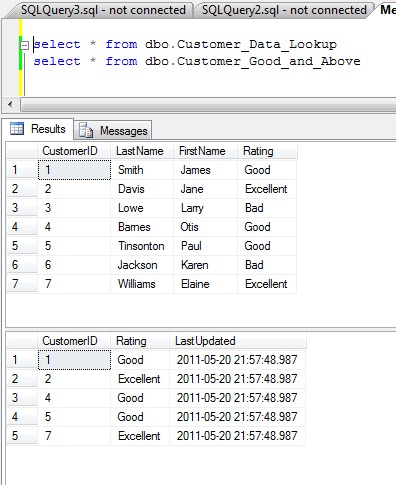To accomplish this, you can use the OUTPUT clause to get all the updated records only. Then you match those back against the SOURCE to do the INSERT. For each of these comparison conditions code the logic.

When matched , generally an update condition is used. When not matched , generally an insert or delete condition is used. Check out the example below with product data to get started down the path of becoming an expert with the SQL Server MERGE command to streamline your T-SQL logic.
Merge into with multiple updates and inserts. Ask Question Asked years, months ago. WHEN MATCHED THEN UPDATE SET TARGET. MERGE with DELETE and INSERT operators: MERGE INTO dbo.
I wrote a few years back that for single row operations, MERGE might in fact have a large overhead than the do-it-yourself approach (ie, attempt an update, if it fails, then do an insert). Using MERGE, you can perform so-called upserts, i. An more importantly, with just a single join. Replace the MERGE statement with an insert or an update statement. SELECT ColColFROM tblSource.
It can be used to combine insert, update, and delete operations into one statement. The MERGE statement is used to make changes in one table based on values matched from anther. In this article, we’ll explore how to use the MERGE statement.

We discuss some best practices, limitations, and. A MERGE statement must be terminated by a semi-colon (;). Now if I comment out the last line of code which is an update statement the syntax executes perfectly. The value specified for the primary index in the INSERT. Hi Tom, Recently I had a technical interview in which I was asked the disadvantage of Merge.
When I asked back what the answer was, The person said that if the Number of updates were high then its better to have a Update followed by a Insert. Ein häufiges Szenario ist die Aktualisierung einer oder mehrerer Spalten in einer Tabelle, wenn eine übereinstimmende Zeile vorhanden ist. What is the Difference Between MERGE and UPDATE ? Both the MERGE and UPDATE statements are designed to modify data in one table based on data from another, but MERGE can do much more.
Whereas UPDATE can only modify column values you can use the MERGE statement to synchronize all data changes such as removal and addition of row. Actually I wanted to start dimensions and measures with an example of slowly changing dimension component but suddenly changed my mind and thought before jumping into that let me just show you how to do insert and update data table using merge join then same load and update data table can be seen using slowly chagining dimension component. Free Oracle Magazine Subscriptions and Oracle White Papers: Oracle Merge Statements: Version 11. Note: Primarily of value when moving large amounts of data in data warehouse situations. In Oracle 9i only the INSERT and UPDATE parts were supporte in Oracle 10g DELETE was added.
The merge _ update _clause and merge _ insert _clause became optional. The basic syntax for the MERGE statement: DELETE can only occur in the merge _ update _clause of the above schema. But remember - performance would be a bad compared to your normal insert - as it has to scan all the records and do a dummy update if exists.

If you have table data of 1and new records are there - you will get 1records processed with that merge statement instead of records getting processed. The Oracle MERGE statement selects data from one or more source tables and updates or inserts it into a target table. In Oracle 10g Release the MERGE statement gained the ability to delete rows, as well as update and insert them.
MERGE is designed to apply both UPDATE and INSERTs into. This Oracle tip shows you how it works. I have a TARGET table and a SOURCE table. I am using the MERGE command.
Say you would like to take transformed data and use it to update our dimension table.
Brak komentarzy:
Prześlij komentarz
Uwaga: tylko uczestnik tego bloga może przesyłać komentarze.